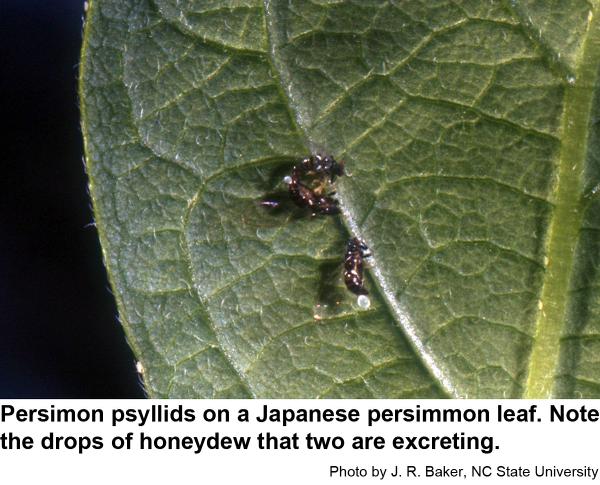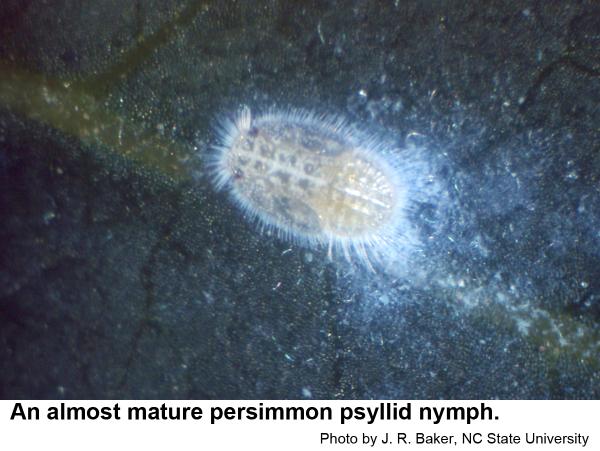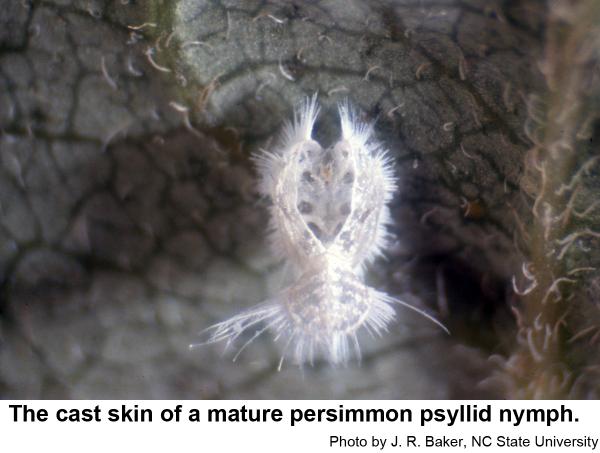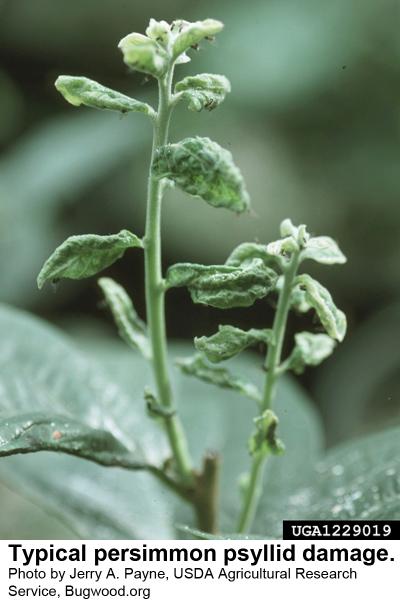Description and Biology
Persimmon psyllids or persimmon psyllas, Baeoalitriozus diospyri or Trioza diospyri, are small insects (between 1/8 and 3/16 inch). Adults hold their wings high over their bodies, and they jump readily. Nymphs are flattened and less active than adults and they secrete a white fluff. Older nymphs also secrete a slender fringe around the periphery. Females lay eggs that hatch and develop through about five growth stages before maturing into winged adults. Psyllids become abundant in spring when temperatures warm and host plants produce new, tender growth. Development from egg to adult takes only a few weeks in spring. Hot weather can suppress persimmon psyllid populations. On native persimmon, these psyllids can be temporarily abundant; but their populations soon decline naturally, as they are attacked by their natural enemies, including parasitic wasps.
Host Plants
Persimmon psyllids feed on Japanese persimmon as well as ornamental and native persimmons. Persimmon psyllids inject their saliva and suck out plant juices. Infested leaves are often misshapen. Nymphs secrete white fluff and also cause terminals to twist and become galled. Psyllids also excrete sticky honeydew on which dark sooty molds may grow. Excessive honeydew may disfigure plants or property below the infested foliage.
Residential Recommendations
Minimize shearing or clipping of terminals during the growing season. Shearing stimulates new growth preferred by psyllids for feeding and egg laying. Prune plants just above branch crotches and nodes instead of shearing off terminals. Horticultural oils suppress adult and immature persimmon psyllids without leaving a toxic residue that might harm beneficial insects and mites. Most insecticides labeled for residential landscape use will give adequate control although the pyrethroids are harsh on beneficials. When used as directed, pyrethroids are very toxic to insects but are not particularly hazardous to humans and pets (other than fish-avoid using pyrethroids around pools, ponds, and streams).
Other Resources
- Home Garden Persimmons. Krewer, G. and D.L. Horton. 2009 (reviewed). Univ. Georgia Cooperative Extension Circular 784.
- Persimmon Psylla, Trioza diospyri (Ashmead), (Homoptera: Psyllidae). Mead, F. W. 1966. Entomology Circular No. 50. Florida Department of Agriculture, Div. Plant Industry.
- Psyllids. Kabashima, J. N. et al. 2014. Pests in Gardens and Landscapes. Univ. California Agr. Nat. Resources. Publication 7423.
- Extension Plant Pathology Publications and Factsheets
- Horticultural Science Publications
- North Carolina Agricultural Chemicals Manual
For assistance with a specific problem, contact your local N.C. Cooperative Extension Center
Publication date: Nov. 7, 2018
Reviewed/Revised: Oct. 9, 2019
Recommendations for the use of agricultural chemicals are included in this publication as a convenience to the reader. The use of brand names and any mention or listing of commercial products or services in this publication does not imply endorsement by NC State University or N.C. A&T State University nor discrimination against similar products or services not mentioned. Individuals who use agricultural chemicals are responsible for ensuring that the intended use complies with current regulations and conforms to the product label. Be sure to obtain current information about usage regulations and examine a current product label before applying any chemical. For assistance, contact your local N.C. Cooperative Extension county center.
N.C. Cooperative Extension prohibits discrimination and harassment regardless of age, color, disability, family and marital status, gender identity, national origin, political beliefs, race, religion, sex (including pregnancy), sexual orientation and veteran status.






